
Flannigan's Hill
American Sabbatical 011: 9/11/96
Spoon River
9/11.. Going downstate.
We cut west out of Lake Bluffs trying to dodge the interstate and exurb, but it was 50 miles
before we broke out into farm country, and even then the traffic
was thick. The auto has clogged the arteries of small town middle
America, too. Our goal was Lincoln Country, but there’s a lot
of corn between here and there.
The great expansiveness, the simple rectilinearity of the road
grid, the hard-edged storage bins and silos, the gleaming pickups,
all taken at 55 mph, are quite soothing. You can understand how
refugees from the turmoil of Europe in the 1840’s would find this
rich and simple land a paradise. Of course they didn’t appreciate
the pickups.

Flannigan's Hill
Our first day southing was so horizontal that our first hillock came as a shock. It was just outside Normal in a place called Flannigan, and the story was obvious. Flannigan, the poor bedeviled Irishman, fated to scratch the sod in this everlasting level, just couldn’t stand the blessed normality of it all. Every time he took solace in the sauce he’d fill his barrow with good black dirt, wheel it up to his little mound, and dump it. His wife and children thought him mad to wish for altitude in the comforting flatness, but figured it was some strangeness he’d brought from the old sod. After 50 years of laughing at the old man’s elevated stubbornness, folks began to notice that there were always birds soaring over the Flannigan place and a cooler air flowing around it. Flannigan’s Folly had become a landmark, the notch on the horizon a man could use to line up his furrows. When the old man died at 96, the neighbors put on a great display of fireworks from atop the hill, and renamed the town in his honor. Now mothers from all over the county bring their children to Flannigan’s hill to feel what climbing is like, and enlarge their horizon’s. “Like sledding on Flannigan’s Hill,” has become synonymous with fast living, and if you don’t believe me, the hill’s still there.
That was our big excitement of the day, and we came to rest at
the High Corn KOA conveniently situated between the Interstate
and the railroad line, so we could enjoy the throbbing power of
our national commerce all night. It was sparkling clean, however,
and a clean john gets to be memorable on the camp trail.
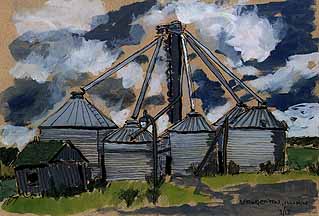
Silos (Bryce)
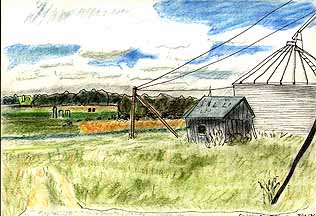
Silos (Peggy)
In the morn we found our way through the ripening foodstuffs to
Petersburg, a classic county seat with courthouse square and all.
Edgar Lee Masters lived here and Lincoln surveyed the town in
his chain-carrying days. We paused on the hill above town to visit
the local graveyard, thinking of Spoon River and Masters’ imagination.
There were stories to be conjured among the old gravestones. Husbands
with three wives. Nephews buried among sons. Extraordinarily elaborate
carvings to commemorate infants of 3 months.
The sense of history rears up with the mossy stones in a local boneyard. When we couldn't find any of the characters from Spoon River in the cemetery, we thought that Masters had been clever to change the names, and invent the tales. Turns out that Spoon River was actually Lewiston, and Masters WAS truth-telling. We were in the wrong cemetery. Over to Lewiston, where the names are the same, the neighbors didn’t like it a bit.
(Memo #11)
Sept. 12 - EDGAR LEE MASTERS: SPOON RIVER
Who? Edgar Lee Masters, author of Spoon River Anthology.. Abraham
Lincoln
What? Masters' hometown and source of inspiration, his house and
town graveyards and town where Lincoln began law practice
Where? Petersburg, Illinois
When? late 19th century
How? family home is open to the public
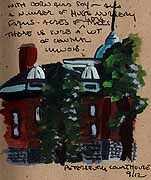
Petersburg
Courthouse
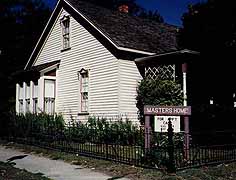
The Masters' House
In the central Illinois town of Petersburg, I found the childhood
home of Edgar Lee Masters, the author of Spoon River Anthology.
It was a small white clapboard house with a crocheted lace curtain
on the front door stating “Home of Edgar Lee Masters.” Although
tours were over for the season, I went to the nearby historical
society where a nice lady called around to find a guide. Well,
one guide couldn’t come because the “mayor was out of his office.”
Another said she could meet me at 1 pm, was that Ok? Of course.
I spent the time in the courthouse looking at legal documents
drawn up by Lincoln or his law partners. Lincoln spent his 20’s
in a small hamlet outside Petersburg called New Salem and was
the surveyor who began laying out Petersburg (commemorated in
an historic marker in a corner of the central square). When he
later became a lawyer many cases on the circuit brought him to
Petersburg. His adult home was in Springfield, the second state
capital, some twenty-two miles away.
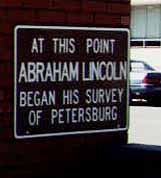
Right here
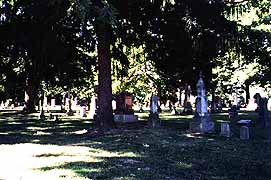
Tranquillity
All of which is to say that Masters grew up very much within the
Lincoln myth. Masters is in fact buried in the same cemetery as
Ann Rutledge, Lincoln’s first love AND Master’s epitaph for Ann
Rutlege has been carved on a modern grave marker for her! Layers
upon layers of history.
At one I was let into the house. It has many cabinets with displays of Masters memorabilia; he lived there through his childhood and into his early teens, when he and his family moved to Lewiston, Illinois. All the books he wrote were on one bookshelf, posters from the many presentations based on Spoon River in another, some family artifacts including his obituary and funeral pictures. My hostess (a young woman who had lived in town most of her life) pointed out that three of the pallbearers for Masters still lived in town - one was the oldest practicing lawyer in Illinois!!!!
I began to ask questions. It turns out that MOST OF THE CHARACTERS
IN SPOON RIVER ARE REAL. Some were barely disguised. “Everyone
around here knew who they were!” my guide continued.” You can
bet he wasn’t very popular.” For example, Lucinda Matlock was
his grandmother! Some of his characters are buried in the graveyard
at Lewiston. Each June the town has a reading IN the graveyard.
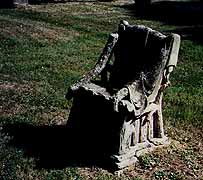
Shades